There are few people who won’t immediately recognize The Creation of Adam, the most famous of nine frescos painted on the ceiling of the Sistine Chapel by Renaissance master, Michelangelo. The Sistine Chapel is a Papal Chapel built within the Vatican between 1477 and 1480 by Pope Sixtus IV. It was painted in 1511 and was originally commissioned by Pop Julius II. The ceiling of the Sistine Chapel has gone through a series on very long and very tedious renovation efforts that went on between 1980 and 1999.
“The Creation of Adam” is the fourth in a chronological collection of panels depicting moments from the Hebrew Bible’s Book of Genesis. In the upper right, God is depicted as an old long-bearded man, while Adam, on the lower left, is fully nude. God’s right arm extends to Adam, his hand offering the spark of life to Adam’s hand, “whose left arm is extended in a pose mirroring God’s, a reminder that man is created in the image and likeness of God (Gen 1:26).” (Wikipedia)
Like any famous works of times past, they will be homaged and parodied in following generations. Sometimes the references will have a sub-context, and other times they will just mirror the composition of the masterpiece. Below I present you six works inspired by “The Creation of Adam,” but these are only a few examples of the many still out there, and many still to come.
I’m going to start off by presenting a movie poster that is the most iconic retro reference to Michelangelo’s “The Creation of Adam” immediately recognizable to any kid of the 80’s. Steven Spielberg’s movie about an alien getting stranded on earth, later to be found by a young boy, is one of those hallmark films the define the 1980s scifi cinema.
The John Alvin promotional movie poster makes a direct reference to the “spark of life.” Whereas, the fingers of God and Adam don’t quite touch–a detail specifically intended to create visual tension–the fingers of E.T. and Elliot actually depict the “spark.” The religious parallels of life, death, and resurrection, are also relevant to the film. This homage can’t be coincidental, this is an example of great subtext.
“Touched by His Noodly Appendage” was originally created in August 2005 by the Swedish designer Niklas Jansson. It features the Flying Spaghetti Monster, a controversial parody creation of Bob Henderson.
If you’re unfamiliar with the origins of this internet troupe, here’s the short of it from Wikipedia: The “Flying Spaghetti Monster” was first described in a satirical open letter written by Bobby Henderson in 2005, protesting the decision by the Kansas State Board of Education to permit the teaching of intelligent design as an alternative to evolution in public school science classes.”
I encourage you to read about this topic. It’s intriguing how quickly it’s gained popularity thanks to the internet. It even has its own Church of the Flying Spaghetti Monster!
“The Creation of Muppet” by the ever brilliant retro parody artist, James Hance, features Jim Henson surrounded by his muppet creations as he reaches out to the Muppet mascot, Kermit the Frog. A thematically relevant lily pad covers Kermit’s private parts.
Jim Henson has entertained generations of kids (and adults) for decades. Most of his creations are featured in TV and films, the most famous being The Muppets and Sesame Street, but other properties remain equally unforgettable: Fraggle Rock, Labyrinth, The Storyteller, and The Dark Crystal. If there could ever be a meta-level comparison between God and Man and Puppeteer and Puppet, there’s no one today who can compete with Jim Henson for the title!
Shigeru Miyamoto is best known for his prolific work for Nintendo. He is the creator of many famous game properties: Mario, Donkey Kong, Legend of Zelda, and Star Fox just to name a few. Not a bad lineup, huh?
The Creation of Mario by TsaoShin is an homage piece that tries to capture Miyamoto’s considerable influence on Nintendo’s portfolio, and on the gaming industry as a whole. The raccoon-morphing leaf covering Mario’s private parts is an amusing touch.
Here are Beavis and Butt-Head, the controversial 90s dumbass duo that had teens in highschool chuckling with a “huh huh” every time they heard someone say words that had sexual connotation, even in the most limited of forms.
These socially awkward metal fanatics spent most of their days skipping school and watching music videos. I’m not entirely sure what the subtext of this parody is by depicting Butt-Head as God, but I can’t help but think there really is none. Well, except to setup Beavis saying something like, “Hey Butt-Head, huh huh, pull my finger, huh.”
That’s all I got.
Michelangelo’s masterpiece even gets referenced within the pages of a comic book from the early 80s. In the concluding chapter of The Great Darkness Saga story arc, written by Paul Levitz with art by Keith Giffen, within the pages of The Legion of Superheroes #294 (published in 1982), across a double-page spread, we see Darkseid attacking the Legion members, Shadow Lass and Light Lass.
In my opinion, this is a case where, again, there really is no subtext to the homage. I wish there were. I think homages are more powerful as symbolic sub-layers to the narrative when there is something deeper to be said for those who are aware of the original piece of work being referenced. It’s not as if Darkseid created Shadow Lass… it’s not as if the scene portrays the creation of superpowered mortals… If someone else, who’s more in “the know” about this story arc wants to chime in, please comment below. Enlighten me!
Image Credits:
E.T. Poster: [IMP Awards]
Touched by His Noodly Appendage [Wikipedia]
The Creation of Muppet [JamesHance.com]
The Creation of Mario [DeviantArt]
Beavis & Butt-Head: [StarPulse.com]
Legion of Superheroes #294 double-page spread: [Comic Coverage]
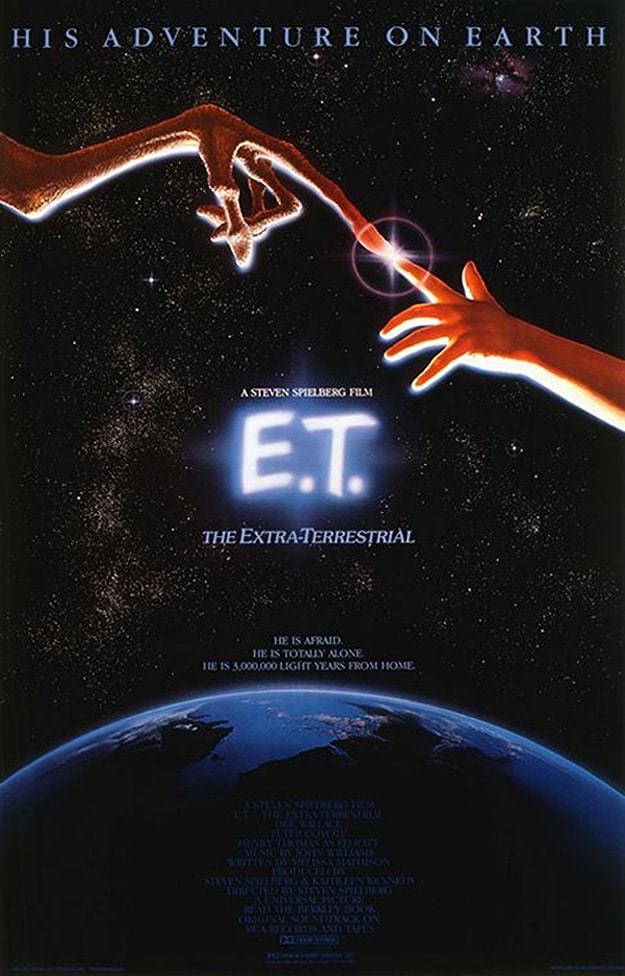
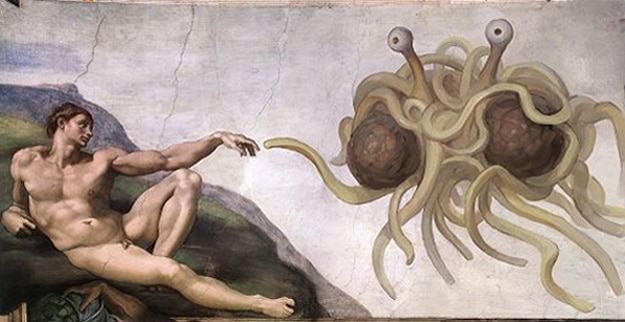
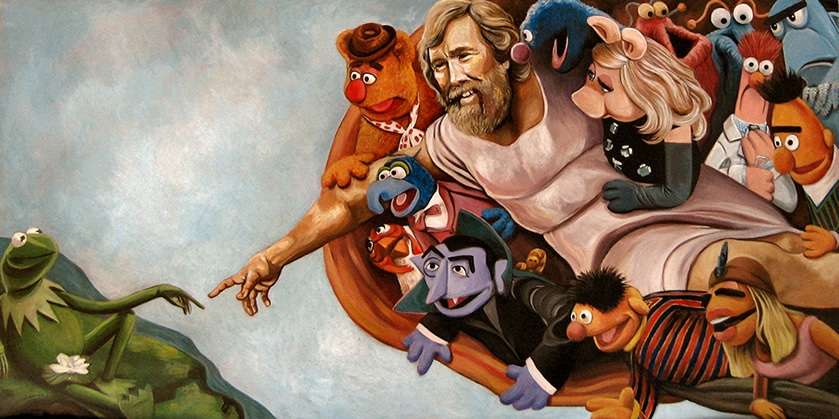
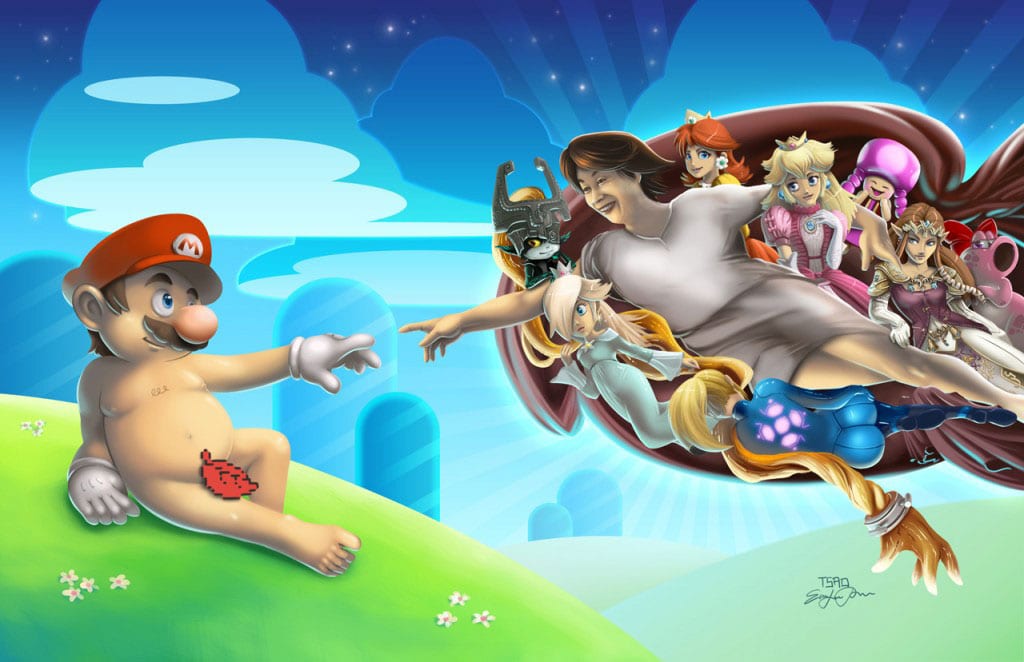
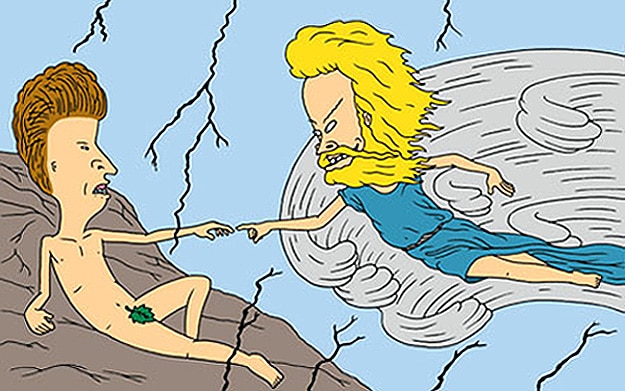
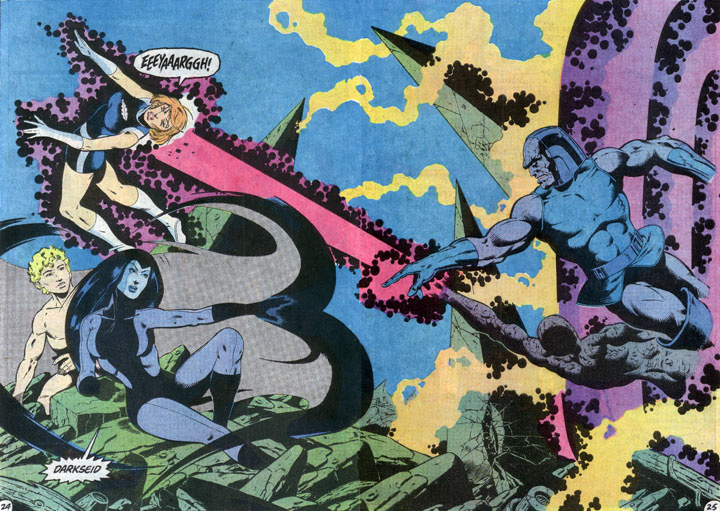
COMMENTS